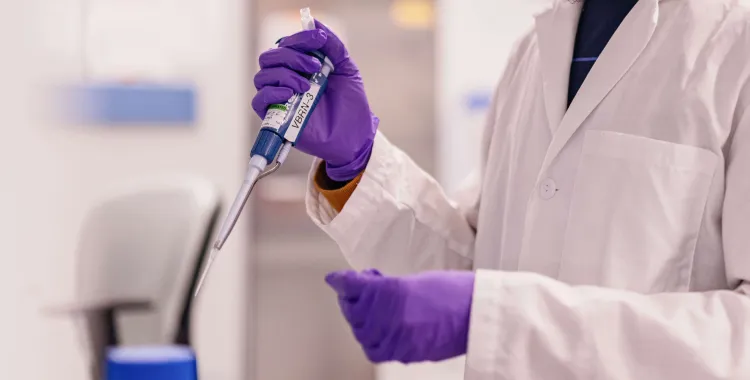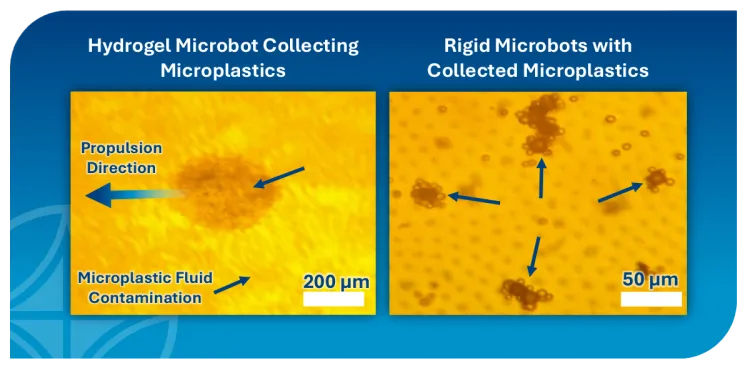In Vermont, Applied Research Associates, Inc. (ARA) conducts leading edge research in sensors, geotechnology, and robotics. ARA, an international technology solutions company with a Randolph manufacturing and research center, is focused on advancing innovations that improve safety, security, and quality of life across markets including national security, infrastructure, health, energy, and environment.
We connected last year when engineers at ARA reached out to UVM to explore a new research partnership. They were interested in whether their microscopic robots – microbots – might provide a new way to remove microplastics from water. Now, UVM is teaming up with the tech company to tackle microplastics.

Microplastics – tiny plastic particles that pollute the environment – have invaded Vermont’s waterways. Their impact on aquatic life and ecosystems is concerning, but so is their impact on human health. Emerging research suggests they may be negatively affecting cardiovascular and digestive systems in our bodies. Because of their size, microplastics are particularly difficult to find and to remove.
For years, ARA has worked toward the development of microbots for less invasive medical procedures and targeted drug delivery. Now, researchers hope to leverage this same nanotechnology to address increasingly pressing environmental concerns like microplastics.
The Leahy Institute enthusiastically supported a small grant to kick start this partnership. For the past year, Dr. Louis William Rogowski, a senior scientist at ARA, has been working diligently with Dr. Laura Treers, an assistant professor in UVM’s Department of Mechanical Engineering, to develop a remediation strategy to remove microplastics from Vermont ecosystems using microrobots.
“We wanted to partner with a local institution that had a strong track record for environmental conservation,” — Dr. Louis William Rogowski, Senior Scientist, ARA
“The University of Vermont was the perfect choice, especially with their new Casella Center for Circular Economy changing the way we approach environmental concerns. Additionally, determined new faculty like Dr. Laura Treers are perfect for pursuing mutually beneficial partnerships in the robotics space. I have no doubt that ARA and UVM will be able to make novel strides in microplastics removal, using microbots and other advanced technologies, for years to come,” said Rogowski.
Microrobots can be outfitted with chemicals that attract and collect microplastics. They navigate via remote control in water, collecting the microplastics that are then removed. Rogowski and Treers are exploring how magnetic control over the microrobots might allow them to remove additional hazards in the environment, like viruses, bacteria, or heavy metals.

The partnership between ARA and UVM is accelerating the critical research behind this innovative solution by combining the strengths of a university research lab with that of an internationally recognized technology development company.
"My lab in the Mechanical Engineering Department at UVM focuses on field robotics and robots for complex outdoor environments,” Treers said. “Through partnering with ARA, we’re now leveraging my lab’s expertise to help bring a technology that has remained in the laboratory environment into the real world, mounting a microplastic removal technology on a larger platform which can navigate shallow waterways throughout Vermont. I hope that through working with ARA, we can help translate some of our scientific aims towards technologies that will directly help Vermont communities."
Both partners see promising opportunities for this project in the near future, and they are planning a second, pilot phase in Vermont. In the next phase, Rogowski and Treers will develop a remediation platform to remove microplastics from the state’s aquatic ecosystems. Microbots will be integrated into a new, larger aquatic robot that will navigate Vermont waterways.
The results? Less contamination, and fewer health impacts for Vermonters.
“Bringing UVM research talent together with an important Vermont company like ARA could possibly lead to a novel solution to an urgent environmental challenge. We see tremendous potential in this work and opportunities in this exciting partnership in the years to come.” — Tricia Coates, Director, Leahy Institute for Rural Partnerships
